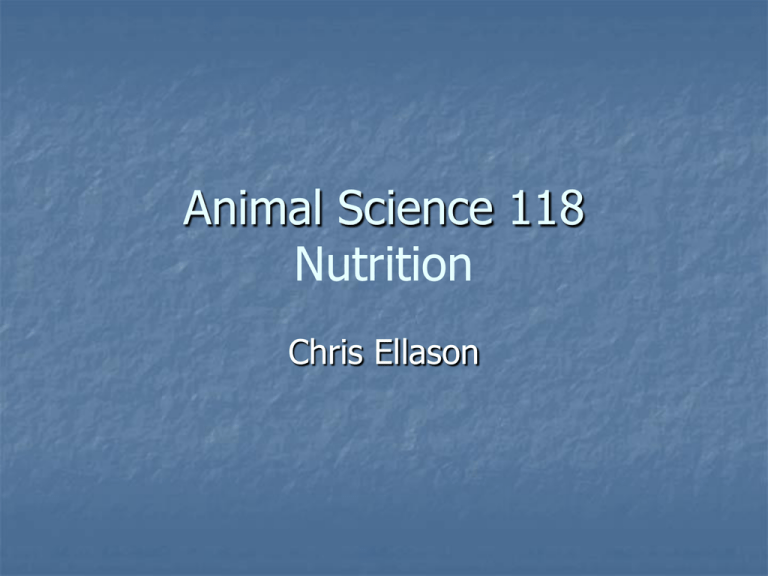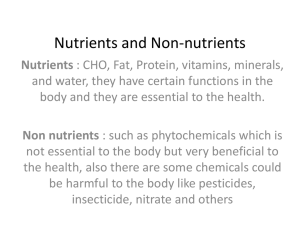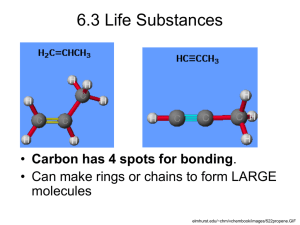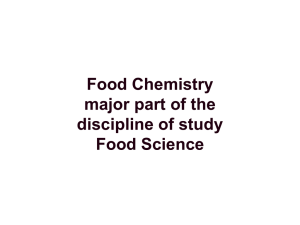Agriculture 597 Advanced Animal Nutrition
advertisement

Animal Science 118 Nutrition Chris Ellason Nutrient Classes Water Carbohydrates (CHO) Lipids (Fat or Ether Extract) Protein Minerals Vitamins Water The most important but most taken for granted nutrient Cheapest most abundant nutrient Animals will die faster due to lack of water than any other nutrient 65 - 85% of animal weight at birth 45 - 60% at maturity Percentage decreases as percent fat increases Water Makes up 90 - 95% of blood 3 Locations of water in body tissue Intracellular Greatest water % of body water (40%) Extracellular water Water in urinary and GI tract Water Functions Transportation of nutrients and excretions Chemical reactions Body temperature regulation Lubrication of joints and organs in body cavity Water Intake Water Consumption of Unstressed animals Swine - 1.5 to 3 gal/hd/d Sheep - 1 to 3 gal/hd/d Cattle - 10 - 14 gal/hd/d Water Turnover In ruminants, body water turnover is about 7 days Nonruminants have a more rapid turnover due to less water in the GIT Slower turnovers are seen in very tolerant animals such as camels and some sheep Carbohydrates (CHO) Made up of C, H and O Makes structural components of plants Formed by Photosynthesis 6CO2 + 6H2O + 686kcal = C6H12O6 + 6O2 Generally provide 50 to 75% of dry matter of food in an animals diet CHO Sugars, starches, & cellulose Simple CHOs, such as Starch, are easily digested and supply the major source of energy for swine and poultry More complex CHO, such as cellulose, are not easily digested and require a microbial interaction for effective utilization Grazing ruminants can make the most effective use of forages CHO 2 classes Fibrous (contains cellulose) Coastal Hay, alfalfa, cottonseed hulls Readily available Milo, Corn, Barley, Wheat Carbohydrate Classification Monosaccharides: simple sugars Hexoses (6 C) Glucose Fructose Galactose Mannose Pentoses (5 C) Arabinose Xylose Carbohydrate Classification Disaccharides: 2 sugar molecules linked together Sucrose (glucose & fructose) Maltose (2 glucose) Lactose (glucose & galactose) Polysaccharides: Many sugars linked together Starch: readily digestible Cellulose: requires bacterial action to break down Carbohydrate Digestion Only Monosaccharides can be absorbed Nonruminant CHO Digestion Salivary Amylase Pancreatic Amylase Other Carbohydrases - cannot breakdown Cellulose because of glucose-4--glucoside linkage When the –OH group on the anomeric carbon is on the same side of the ring as the terminal –CH2OH Alpha vs beta linkage Nonruminant CHO Absorption Glucose and Galactose are readily absorbed Most monosaccharides are converted to glucose in SI mucosa Very high percent of absorption occurs in first two sections of SI Ruminant CHO Digestion What’s the difference from nonruminants? Ruminant CHO Digestion Very little if any Salivary Amylase Lower amounts of Pancreatic Amylase Bacteria in rumen have cellulase Conversion of CHO to VFAs 75 - 80% of ruminant energy is from VFAs VFA Metabolism There are 3 major VFAs Acetate Propionate Butyrate They occur in concentration as listed above VFA Metabolism How do the relative concentrations of these change? As grain increases in the diet, propionate increases As fiber increases in the diet, acetate and butyrate increase Fat or Lipid Metabolism Fatty Acids can range from 2 to 24 C in length Saturated Fatty Acids No double bonds in the chain Solid at room temperature Butyric Acid Stearic Acid Lipid Metabolism Unsaturated Fatty Acids One or more pairs of C have double bonds Liquid at room temperature Number of double bonds denoted in name Oleic Acid (C18:1) Linoleic Acid (C18:2) Lipid Functions Supply Energy source of essential fatty acids carry fat soluble vitamins cell membrane structure hormone precursor Lipid Metabolism As saturation increases melting point decreases Iodine number denotes degree of unsaturation Ex C18:1 Lipid Metabolism Upper Small Intestine is major site of absorption Differences in Ruminant and nonRuminant Lypolysis occurs further up the tract in the ruminant In nonruminant occurrence is in small intestine Fatty acids are neutralized in the rumen Lipid Metabolism Ruminants utilize essential fatty acids much more efficiently than nonruminants This is important due to extreme hydrolysis happening in the rumen Ruminants store 27 to 29% of fat as 18:0 This % is only about 5 in nonruminants Lipid Metabolism Essential Fatty Acids Linoleic acid (C18:2) Linolenic acid (C18:3) Arachidonic acid (C20:4) - Can be synthesized from linoleic therefore only required if linoleic is absent Protein Structure Classification Terminology Protein Quality Protein Quality Ruminants Digestion and Metabolism Protein Structure All proteins have one common property All are made up of chains of amino acids Essential Amino Acids 22 Amino Acids total 10 are Essential Pvt Tim Hall Essential Amino Acids Phenylalanine Valine Threonine Tryptophan Isoleucine Methionine Histidine Arginine Leucine Lysine Protein Classification Simple Proteins: Those yeilding only amino acids Albumins: soluble in water Globulins: soluble in dilute neutral solutions salts Protein Classification Fibrous Proteins: Constitutes about 30% of total protein in animal body; connective tissue Collagens: insoluble in water; become digestible after conversion to gelatin in dilute acids or bases Elastins: similar to collagens but cannot be converted to gelatin Protein Classification Conjugated Proteins: those in which proteins are combined with a nonprotein radical Glycoproteins: contain CHO Phosphoproteins: contain phosphorus Lipoproteins: contain lipids Protein Terminology True Protein: composed only of amino acids Nonprotein Nitrogen: not true protein in nature but contain N and can be converted to protein by bacterial action Digestible protein: portion of the crude protein which an animal can digest Absorbable protein (Metabolizable Protein): accounts for the quality and quantity of protein leaving the rumen Protein Quality Biological value: measure of the relationship of protein retention to protein absorption BV (%) = N intake – (Urinary N + Fecal N) X 100 N intake – Fecal N Protein efficiency ratio: Protein sources are compared in terms of gain in animal weight per gram of protein or N fed Ruminant Protein Quality Microbial Protein: Poor quality proteins & NPN can be upgraded by rumen fermentation to microbial protein Bypass Protein: Proteins that bypass rumen fermentation and go directly into the omasum Can be used more effeciently Protected Protein Digestion and Metabolism Fate of Amino Acid Breakdown Tissue protein synthesis Synthesis of enzymes, hormones Energy









